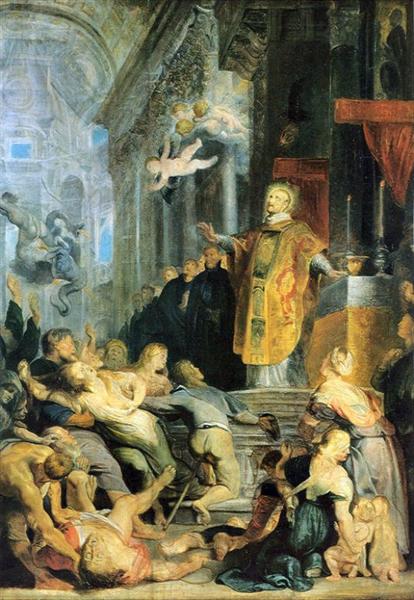Beschrijving
Peter Paul Rubens' painting "The Miracle of St. Ignatius of Loyola", created in 1617, stands as a masterful example of Baroque devotion and the artist's personal style, whose mastery in depicting human dynamism and religious emotion is undeniable. This work is set in a context where Rubens was not only a notable painter, but also a keen observer of the spirituality of his time, a legacy that is manifested in this piece through its intense visual narrative.
In the structure of the composition, Rubens displays a scene full of movement and drama. In the centre, we can see Saint Ignatius of Loyola, whose figure exudes an aura of serenity and spiritual authority. The saint is faithfully represented at the moment of his miracle, where he helps a fallen teenager who is seen kneeling before him. This interaction establishes a visual and emotional link that draws the viewer into the act of faith depicted. The arrangement of the characters in a pyramidal format directs the gaze towards the saint, creating a hierarchy that underlines his importance in the narrative.
The vibrant colours of the work are a hallmark of Rubens’ style. The rich palette he employs enhances the luminosity of the painting, while the interplay of colour and light contributes to an almost heavenly atmosphere. The golden hues adorning St. Ignatius’ vestments shine in contrast to the darker colours used in the background, which in turn reinforces the idea of divinity and heavenly aspiration. The faces of the characters, each carefully modelled, feature a palette of tones ranging from warm beige to pink, bringing to life their expressions of wonder and reverence.
One notable aspect is the inclusion of a wide spectrum of characters in the scene, reflecting a range of reactions to the miracle. Those surrounding St. Ignatius display postures ranging from devotion to surprise, encapsulating a multitude of human emotions that complement the saint's spirituality. This representation of the community in the painting denotes the importance of St. Ignatius not only as an individual figure, but as a symbol of unity and faith for a broader group.
Rubens, known for his ability to blend the earthly with the divine, succeeds in establishing a connection between miracle and human experience. It is not simply a depiction of a miraculous feat; it is an exaltation of faith carried out in a community context. The facial expressions reflect not only surprise at the supernatural, but also the hope that the miracle represents for those who seek the saint's intercession.
In terms of its place in art history, The Miracle of St. Ignatius of Loyola aligns with other works by Rubens that address religious themes, such as The Elevation of the Cross or The Adoration of the Magi, where movement, light and the representation of the human body play fundamental roles. This particular miracle also responds to a historical context marked by the Counter-Reformation and the importance of art as a means of promoting the Catholic faith, a common thread in many of his works.
In conclusion, “The Miracle of Saint Ignatius of Loyola” encapsulates Rubens’ mastery in the use of color, composition, and expressiveness. The work not only represents a moment of faith linked to the context of the saint’s life, but is also a testament to the power of art to evoke spirituality. Through his ability to communicate the sacred through the human, Rubens manages to capture the essence of the miracle, turning painting into a meeting point between devotion and masterful artistic technique.
KUADROS ©, a famous painting on your wall.
Hand-made oil painting reproductions, with the quality of professional artists and the distinctive seal of KUADROS ©.
Painting reproduction service with satisfaction guarantee. If you are not completely satisfied with the replica of your painting, we will refund 100% of your money.

